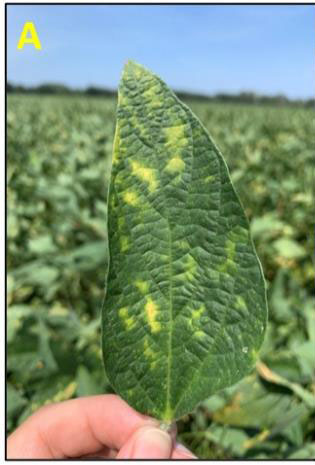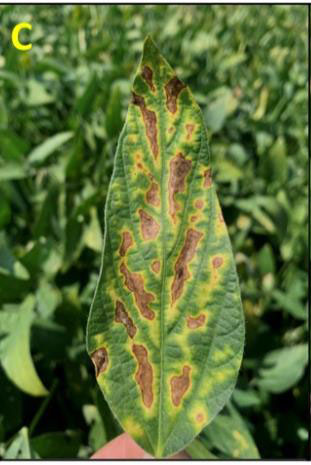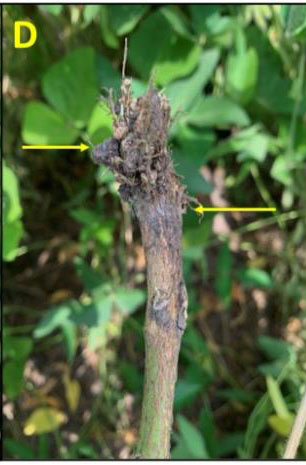Soybean Disease Update
In the last two weeks, cases of soybean fields showing symptoms of Charcoal rot have increased across the state. Soybean fields affected by the disease were already confirmed in Tulsa, Delaware, Okmulgee, and Pottawatomie counties. The symptoms of this disease in soybean plants can be easily mistaken for drought, heat stress, and soil compaction. Patches in the middle or at the edges of the field showing plants that died prematurely or with wilting symptoms are a good indication of Charcoal rot (Figure 1). More information about Charcoal rot and how to correctly identify this disease in soybean fields across Oklahoma state can be found in the following publication.
Figure 1. Patch in the soybean fields where the plants are yellow, wilted and prematurity dying due to Charcoal rot infection.
As a result of the rains that we got in some areas across Oklahoma at the beginning of August, a very important disease started to show up in soybean fields in the Central parts of the state: Sudden Death Syndrome (also known as SDS).
Sudden Death Syndrome: This disease is caused by a fungus, Fusarium virguliforme, that infects soybean plants early in the growing season within a few days after planting. High soil moisture levels associated with cool temperatures favored the infection of the roots by the pathogen. However, foliar symptoms observed in the upper canopy rarely occur after flowering. Once the plants are infected, rainfall events during the reproductive growth stages favor foliar symptom development. Soil compaction and the presence of Soybean cyst nematode (SCN) can increase disease severity.
Disease symptoms: Foliar symptoms observed in soybean plants result from a toxin produced by the fungus that moves from the infected roots up to the leaves. Early foliar symptoms of Charcoal rot start as scattered, yellow spots between the leaf veins (Figure 2A). As the disease progresses, the spots become brown (Figure 2B), and start to enlarge and coalesce to form large, yellow blotches and patches of dead tissue between the leaf veins (Figure 2C). Plants infected with SDS can have rooted roots. Blue fungal growth may be seen on the surface of the rooted roots when the soil moisture level is high (Figure 2D).
| Image | Caption |
|---|---|
 |
A) Early foliar symptoms of Sudden death syndrome in the soybean plants. |
 |
B) Symptoms of the disease progressing from yellow spots to brown spots in the soybean leaves. |
 |
C) Leaves with interveinal chlorosis and necrosis while the prominent lateral veins remain green. |
 |
D) Rotted roots caused by the Fusarium virguliforme infection, with yellow arrows indicating fungal growth with a blue color. |
Figure 2. A, B, C and D
Disease management: Management options for SDS are limited. Although soybean cultivars that are less susceptible to SDS have been developed, no highly resistant cultivars are available. Fungicides applied in-furrow during planting or as seed treatments have limited effects on disease reduction. Fungicides applied to foliage have no effect on SDS suppression, since the fungal infection is restricted to root systems, and fungicides typically do not move downward in the plant to reach this site of infection. Management practices used to reduce the risk of SDS damage include:
- Planting dates: Early planting predisposes soybean plants to infection. In cold, wet soils, young soybean plants are vulnerable to infection by the SDS pathogen. Delaying planting until the soil has warmed and avoiding ultra-early planting dates is recommended to decrease the disease risk. Fields with no history of SDS should be planted first; fields where SDS has been a problem should be planted last.
- Crop rotation: Crop rotation may reduce the disease risk by reducing the inoculum of the pathogen in the area. However, crop rotation with corn does not reduce the incidence of SDS. Although the pathogen does not cause disease in corn, it can survive in the corn residue and increase over time. Breaking up a corn-soybean rotation with another crop (such as wheat or other small grains) can reduce disease.
- Resistant soybean cultivars: Farmers should select soybean cultivars that have partial resistance to SDS and that contain resistant genes to Soybean cyst nematode (SCN) since SCN infestation in the soil can increase the risk of SDS infection.
Please contact your local county extension office from Oklahoma State University for current information about this disease in the state.
If you are curious to learn more about Sudden death syndrome (SDS) in soybeans, please consult the following publication for more information.
References:
Westphal, A., T.S. Abney, L.J. Xing and G.E. Shaner. Sudden Death Syndrome of Soybean. 2008. The Plant Health Instructor. DOI:10.1094/PHI-I-2008-0102-01. Updated 2018.

